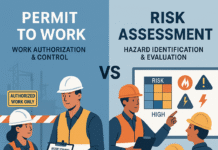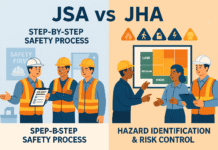
Electrical Work Risk Assessment
📘 Introduction
Electricity is a powerful ally—until it’s not. From installing switchboards to repairing live circuits, electrical work poses serious hazards if not carefully assessed and controlled.
That’s why an Electrical Work Risk Assessment is a fundamental part of any workplace safety program. Whether you’re in construction, manufacturing, maintenance, or utilities, this assessment is your tool to prevent shocks, arc flash incidents, fires, and fatalities.
Let’s break down everything you need to know: hazards, controls, regulations, sample matrix, and a complete downloadable assessment table.
📜 Regulations and Standards
Key Guidelines for Electrical Work
- OSHA 29 CFR 1910.333 – Selection and Use of Work Practices
- NFPA 70E – Electrical Safety in the Workplace
- UK HSE – Electricity at Work Regulations 1989
- IS 5216 – Indian Standard for Electrical Safety Procedures
Employer Responsibilities
- Identify electrical hazards.
- Train all authorized persons.
- Provide isolation and Lockout/Tagout (LOTO).
- Use certified tools and PPE.
- Conduct regular inspections and audits.
⚡ Common Electrical Hazards
| Hazard Type | Examples |
|---|---|
| Electric Shock | Faulty wiring, live wire contact, wet conditions |
| Arc Flash | Sudden release of energy during short circuit |
| Fire & Explosion | Due to overloaded circuits, poor insulation |
| Electrocution | High-voltage exposure without proper PPE |
| Burns | Contact with live conductors or hot components |
| Secondary Hazards | Falls due to shock, explosion-related injuries |
| Equipment Damage | Improper earthing or loose connections |
🎯 Why Electrical Risk Assessment Is Crucial
An arc flash event can release heat greater than the surface of the sun. A shock can kill in milliseconds.
An electrical risk assessment helps:
- Identify unsafe practices.
- Define safety procedures.
- Prevent serious injuries or deaths.
- Comply with law and standards.
- Assign roles and controls before the job begins.
📊 Electrical Risk Assessment Matrix (5×5)
| Severity ↓ / Likelihood → | Rare (1) | Unlikely (2) | Possible (3) | Likely (4) | Almost Certain (5) |
|---|---|---|---|---|---|
| Insignificant (1) | 1 | 2 | 3 | 4 | 5 |
| Minor (2) | 2 | 4 | 6 | 8 | 10 |
| Moderate (3) | 3 | 6 | 9 | 12 | 15 |
| Major (4) | 4 | 8 | 12 | 16 | 20 |
| Catastrophic (5) | 5 | 10 | 15 | 20 | 25 |
- Low (1–3): Acceptable with basic controls
- Medium (4–6): Needs mitigation before starting
- High (7–15): Only with strict controls and supervision
- Extreme (16–25): Do not proceed until redesigned or isolated
📌 Electrical Work Risk Assessment Table (Sample)
| S.No | Activity | Hazard | Risk (L×S) | Risk Level | Control Measures | Responsible Person |
|---|---|---|---|---|---|---|
| 1 | Working on live panel | Electric shock, electrocution | 5×4 = 20 | Extreme | Isolate supply, use LOTO, wear rubber gloves, insulated tools, signboards | Electrical Supervisor |
| 2 | Cable pulling in wet area | Short circuit, fire risk | 4×4 = 16 | High | De-energize circuit, use waterproof gloves, rubber mats, dry area before work | Site Electrician |
| 3 | Testing with Megger | Induced voltage causing shock | 3×4 = 12 | High | Discharge all equipment before testing, use signage and barriers, PPE | Testing Engineer |
| 4 | Temporary power connection | Loose wires, overloading | 3×5 = 15 | High | Use certified distribution boards, MCBs, RCDs, proper earthing | Electrical In-Charge |
| 5 | Use of power tools | Damaged cables leading to shock | 3×4 = 12 | High | Inspect cables, double insulated tools, proper grounding | Maintenance Technician |
| 6 | Transformer maintenance | High-voltage arc flash | 4×5 = 20 | Extreme | De-energize, test for absence of voltage, wear arc-rated PPE, install barricades | Senior Technician |
| 7 | Overhead line work | Contact with live conductors | 5×5 = 25 | Extreme | Permit system, use insulated boom lift, maintain clearance, supervision | HSE Officer |
🔌 Lockout/Tagout (LOTO) – Must-Have Procedure
LOTO ensures no accidental energizing of equipment.
Steps in LOTO:
- Inform all affected employees.
- Isolate energy source.
- Lock and tag switch or breaker.
- Release stored energy.
- Test for zero energy before work.
- Remove lock only after confirming safety.
🔐 Every energized system must have a dedicated lockout procedure—no exceptions.
🛠 Tools & PPE for Electrical Work
Essential Tools:
- Insulated screwdriver, pliers, wire strippers
- Megger tester, multimeter
- Earthing rod & discharge stick
- Voltage detection pen
- LOTO kit
Personal Protective Equipment (PPE):
- Electrical-resistant gloves
- Arc-rated face shield or hood
- Safety boots with insulation
- Flame-resistant coveralls
- Safety helmet (non-conductive)
🧯 Emergency Planning & Rescue
Accidents still happen—even with the best plans.
Be Prepared With:
- First aid trained team on-site
- Rescue kit (insulated poles, stretchers)
- CPR certification for key personnel
- Emergency contact numbers on display
- Isolation points clearly marked
🎓 Training & Competency
Only trained and authorized personnel may perform electrical work.
Training Topics Should Include:
- Electrical hazard identification
- PPE usage and selection
- LOTO procedures
- Fire and rescue methods
- Incident reporting
🔁 Refresher training: Once a year or post-incident
📋 Record-Keeping
Keep documented proof of:
- Risk assessments
- LOTO logs
- Energized work permits
- Inspection reports
- Electrical panel labeling
- Annual audit reports
Store digitally or in site HSE binders.
❌ Common Mistakes to Avoid
- Working live without PPE or isolation
- Ignoring environmental hazards like water
- Using damaged or uncertified tools
- Overloading circuits with temporary connections
- Untrained person performing high-risk work
✅ Benefits of a Risk Assessment in Electrical Work
- Prevents fatalities and serious injuries
- Meets OSHA, HSE, and ISO requirements
- Builds a strong safety culture
- Reduces legal liability
- Increases productivity with fewer disruptions
📥 Downloadable Resources
✅ Conclusion
Electrical work is invisible and unforgiving. You can’t always see the danger, but one wrong move could be fatal. That’s why an Electrical Work Risk Assessment must be thorough, job-specific, and reviewed regularly.
Don’t wait for sparks to fly—identify the risk, lock it out, and live to wire another day.
Working at Height Risk Assessment
Chemical Processing Risk Assessment
Manufacturing Plant Risk Assessment
Construction Site Risk Assessment
❓ Frequently Asked Questions (FAQs)
1. Can electrical work be done while circuits are live?
Only if absolutely necessary and with strict controls, special permits, and proper PPE. Otherwise, isolate the system.
2. What is the minimum safe voltage to work on?
There’s no such thing as a safe voltage. Even 50V can cause fatal shock. Always isolate when possible.
3. What PPE is required for 440V panel work?
Arc-rated gloves, face shield, rubber mat, insulated boots, FR clothing, and LOTO must be in place.
4. Is LOTO required for low-voltage systems?
Yes. LOTO is essential for all energy sources—not just high voltage.
5. How often should electrical risk assessments be updated?
Every 12 months, or immediately after any change in process, equipment, or near-miss incident.
























